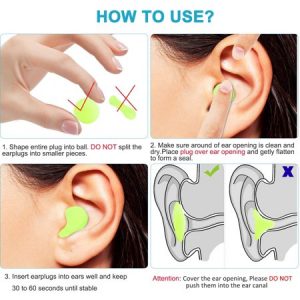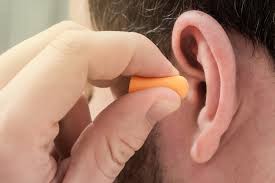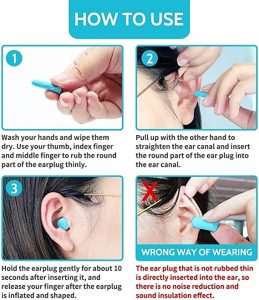Table of Contents
Most earplugs do not guarantee you absolute protection from noise. In addition, different frequencies can become more distinct and annoying; you may even find them difficult to ignore. And some types of earplugs may be more effective at blocking certain sounds than others.
In this article, we’ll compare foam vs silicone ear plugs – two popular types of earplugs – to determine which is best for blocking out the sounds that surround us. We will also examine other factors such as comfort, ease of use, durability, and more. By exploring the differences between foam and silicone ear plugs, you can make an informed decision on which type suits your needs and offers optimal noise reduction.
Benefits of Silicone Ear Plugs
Silicone ear plugs are specialized hearing protection devices made from a soft, flexible material. They are often made with a combination of non-allergenic silicone and rubber, which makes them comfortable to wear for long periods of time. As their name suggests, they fit snugly into the ear canal and help keep out unwanted sound.
Mack’s Pillow Soft Silicone Earplugs

- THE ORIGINAL AND #1 SELLING - USA’s original and #1 selling moldable silicone ear plugs. Provides safe, non-toxic, non-allergenic...
- THE ULTIMATE IN EARPLUG COMFORT - Mack’s soft moldable silicone putty molds very comfortably to the unique contours of any ear. These...
- #1 BRAND FOR SNORING - Mack’s is the #1 Doctor Recommended Brand to get a good night’s sleep when sleeping with a snoring spouse....
Hypoallergenic
Silicone ear plugs have revolutionized the hearing protection industry due to their hypoallergenic properties. Made of medical-grade silicone, they provide a secure yet comfortable fit that is safe for use in sensitive areas like ears without irritating skin or producing an allergic reaction.
Multiple Sizes
Silicone ear plugs are the perfect fit for any size! Unlike traditional foam options, they often come in multiple sizes so you can comfortably and securely block out unwanted noise.
Comfortable For Ears
The main benefit of using silicone ear plugs is that they provide a flexible, reliable fit and seal within the ear canal. They also tend to be more comfortable than foam options as silicone is smoother and softer against the skin. Additionally, some people find it easier to insert and remove silicone ear plugs from their ears compared to foam versions.

Good For Noisy Surroundings
Boasting a noise reduction rating of 22-23 decibels, these ear muffs efficiently block out some sound but not nearly as much as properly fitted foam earplugs (NRR 28-33 dB). Even so, they are an excellent choice for sleeping and other moderately noisy surroundings and are the perfect accompaniment for your sleeping, biking and swimming needs.
Reusable
Silicone ear plugs offer a unique kind of protection and convenience – they’re robust enough to be used over and over again, not wasting money on disposables. Silicone ear plugs should be changed out as soon as their ability to stick diminishes or when they become soiled.
Drawbacks of Silicone Ear Plugs
Can Become Lodged In The Ear Canal
Indeed, due to elevated temperatures within the EAC (ear canal), these silicon and wax plugs take on a dough-like state that could potentially get stuck. Unfortunately, theese earplugs can become lodged into the External Auditory Canal (EAC) and result in acute hearing loss as well as other symptoms.
High Price
Silicone Ear Plugs may come with a higher price tag, but they also offer an unparalleled level of comfort and protection from noise. The price may differ based on the brand and quality of products, but overall they are more expensive than foam ear plugs.
How to improve on the effectiveness of silicone earplugs?
When using silicone putty earplugs, you are limited to a maximum NRR of 22-23 dB in order to protect your hearing. To improve the effectiveness of these earplugs, you can mold and press them into place for a better fit within the ears.
Additionally, sealing off the outer ear with an additional layer such as cotton balls can help reduce sound levels. Lastly, washing your silicone ear plugs in warm water prior to use can also increase their efficiency by restoring its shape and structure to ensure proper coverage within the EAC.
Benefits of Foam Ear Plugs
Foam ear plugs are most commonly made from polyurethane foam and designed to expand to create a snug seal within the ear canal. They typically come in one-size-fits-all cylindrical shapes that can be rolled or compressed for an easier insertion into the ear.

Ease Of Use
Foam ear plugs are most commonly made from polyurethane foam and designed to expand to create a snug seal within the ear canal. They typically come in one-size-fits-all cylindrical shapes that can be rolled or compressed for an easier insertion into the ear.

Blocking Out Different Sounds
Foam earplugs have become the go-to choice for those seeking to block out sound.
In particular at frequencies below 2000 Hz, foam earplugs reduce noise a lot better. This is important if you want to block traffic rumble, loud snoring noise, generator or train engine noise, and other noises with significant amounts of low-frequency noise. Foam earplugs are also better at blocking speech noise (500 – 4000 Hz).
If you are looking for a comfortable, effective way to improve your sleep quality, foam earplugs might be the answer. They’re simple and easy to insert but remember that if you want to reap their full benefits, they must be placed far into your ear canal for optimal results.
Low Price
Foam Ear Plugs are generally cheaper than their silicone counterparts, making them a great choice for those who may be working with a tighter budget.
Amazon’s Best Choice

- ⭐ [SOFT & COMFORTABLE]: Made of Super Soft and Non-toxic Foam, comfy and skin-friendly. Slow rebounded time in 30s-60s to help...
- ⭐ [NOISE REDUCTION--38dB SNR, 31dB NRR]: Tested by professional lab--Micheal & Associates, Inc. High noise reduction rating of 38dB...
- ⭐ [VERSATILE USE]: Ear plugs offer protection from loud noises and background noise in many situations. Great for sleeping, studying,...
Drawbacks of Foam Ear Plugs
May Not Fit Well
On the downside, foam ear plugs may not always be as comfortable as silicone varieties. Despite the fact that foam ear plugs are made of a denser material, many people find them uncomfortable as they expand and apply pressure to the walls of one’s inner ear.
Additionally, unlike silicone ear plugs, foam ear plugs are not adjustable and therefore may not provide a snug fit. In order to feel the full benefits of foam earplugs in blocking sounds, you have to push them deep enough into the ear canal, and many people do not find this safe enough.
Disposable
Foam earplugs don’t last long – they’re made for one-time use only. It’s not just because of dirt and bacteria that can build up quickly; the material itself wears out easily too.
To ensure optimal hearing protection, you should routinely change your earplugs when they are soiled, corroded or no longer retain their original shape. To keep them clean in-between uses, utilize a soft cloth to remove dust and dirt particles.
Can Cause Bacteria Infection
Additionally, foam’s porous nature can lead to bacteria accumulation on the surface if not properly cared for, creating an environment that could potentially cause infection.
How Do Both Types Of Ear Plugs Cope With Occlusion Effect?
For many people, putting on ear protection opens up a world of unwanted noises. Conversations and movements such as talking, eating, or walking can become amplified due to the occlusion effect. That’s because these sounds are not blocked out by the ear protection but instead silicone ear plugs vs foam bounced back off it with an increased intensity that might be irritating or intrusive. This includes commonly heard body-generated sounds like chewing, swallowing, and even our own voices.
Compared to foam earplugs, silicone earplugs only seal the ear openings. This is why molded silicone earplugs have a much greater occlusive effect than their foam counterparts. However, when properly inserted into the bony part of the ear canal (i.e. almost completely filling it), you will most likely not experience this occlusion effect with perfectly fitting foam earplugs!
Video: How to Use Silicone Earplugs. PQ Ear Plugs for Noise Cancelling and Ear Protection
Final Thoughts
Although silicone earplugs provide more effective sound blocking than foam earplugs, the comfort level can be affected by the material used to make each type of earplug. In addition, you need to take into account ease of insertion and removal, as well as overall durability.
Regardless of the type chosen, it’s important to ensure a proper fit in order to get the most out of your earplug choice. Generally, silicone options are recommended for those requiring a more secure fit and all-day comfort, while foam provides a tighter seal and longer lasting protection against noise. Also, foam ear plugs may not be suitable for people with sensitive skin due to their material composition.
On the other hand, silicone plugs are hypoallergenic, durable and can be adjusted to fit the shape of your ear. All in all, both types of earplugs offer strong protection and comfort, depending on the user’s needs. Therefore, choosing between silicone vs foam ear plugs ultimately comes down to personal preference!
